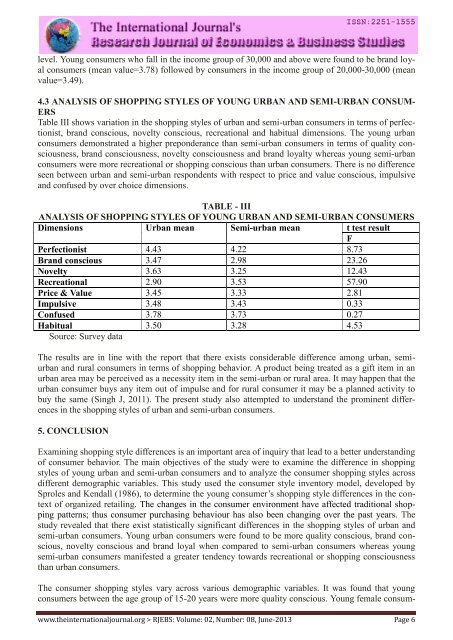Research Journal of Economics & Business Studies - RJEBS - The ...
Research Journal of Economics & Business Studies - RJEBS - The ...
Research Journal of Economics & Business Studies - RJEBS - The ...
- No tags were found...
Create successful ePaper yourself
Turn your PDF publications into a flip-book with our unique Google optimized e-Paper software.
level. Young consumers who fall in the income group <strong>of</strong> 30,000 and above were found to be brand loyal<br />
consumers (mean value=3.78) followed by consumers in the income group <strong>of</strong> 20,000-30,000 (mean<br />
value=3.49).<br />
4.3 ANALYSIS OF SHOPPING STYLES OF YOUNG URBAN AND SEMI-URBAN CONSUM-<br />
ERS<br />
Table III shows variation in the shopping styles <strong>of</strong> urban and semi-urban consumers in terms <strong>of</strong> perfectionist,<br />
brand conscious, novelty conscious, recreational and habitual dimensions. <strong>The</strong> young urban<br />
consumers demonstrated a higher preponderance than semi-urban consumers in terms <strong>of</strong> quality consciousness,<br />
brand consciousness, novelty consciousness and brand loyalty whereas young semi-urban<br />
consumers were more recreational or shopping conscious than urban consumers. <strong>The</strong>re is no difference<br />
seen between urban and semi-urban respondents with respect to price and value conscious, impulsive<br />
and confused by over choice dimensions.<br />
TABLE - III<br />
ANALYSIS OF SHOPPING STYLES OF YOUNG URBAN AND SEMI-URBAN CONSUMERS<br />
Dimensions Urban mean Semi-urban mean t test result<br />
F<br />
Perfectionist 4.43 4.22 8.73<br />
Brand conscious 3.47 2.98 23.26<br />
Novelty 3.63 3.25 12.43<br />
Recreational 2.90 3.53 57.90<br />
Price & Value 3.45 3.33 2.81<br />
Impulsive 3.48 3.43 0.33<br />
Confused 3.78 3.73 0.27<br />
Habitual 3.50 3.28 4.53<br />
Source: Survey data<br />
<strong>The</strong> results are in line with the report that there exists considerable difference among urban, semiurban<br />
and rural consumers in terms <strong>of</strong> shopping behavior. A product being treated as a gift item in an<br />
urban area may be perceived as a necessity item in the semi-urban or rural area. It may happen that the<br />
urban consumer buys any item out <strong>of</strong> impulse and for rural consumer it may be a planned activity to<br />
buy the same (Singh J, 2011). <strong>The</strong> present study also attempted to understand the prominent differences<br />
in the shopping styles <strong>of</strong> urban and semi-urban consumers.<br />
5. CONCLUSION<br />
Examining shopping style differences is an important area <strong>of</strong> inquiry that lead to a better understanding<br />
<strong>of</strong> consumer behavior. <strong>The</strong> main objectives <strong>of</strong> the study were to examine the difference in shopping<br />
styles <strong>of</strong> young urban and semi-urban consumers and to analyze the consumer shopping styles across<br />
different demographic variables. This study used the consumer style inventory model, developed by<br />
Sproles and Kendall (1986), to determine the young consumer’s shopping style differences in the context<br />
<strong>of</strong> organized retailing. <strong>The</strong> changes in the consumer environment have affected traditional shopping<br />
patterns; thus consumer purchasing behaviour has also been changing over the past years. <strong>The</strong><br />
study revealed that there exist statistically significant differences in the shopping styles <strong>of</strong> urban and<br />
semi-urban consumers. Young urban consumers were found to be more quality conscious, brand conscious,<br />
novelty conscious and brand loyal when compared to semi-urban consumers whereas young<br />
semi-urban consumers manifested a greater tendency towards recreational or shopping consciousness<br />
than urban consumers.<br />
<strong>The</strong> consumer shopping styles vary across various demographic variables. It was found that young<br />
consumers between the age group <strong>of</strong> 15-20 years were more quality conscious. Young female consum-<br />
www.theinternationaljournal.org > <strong>RJEBS</strong>: Volume: 02, Number: 08, June-2013 Page 6

















